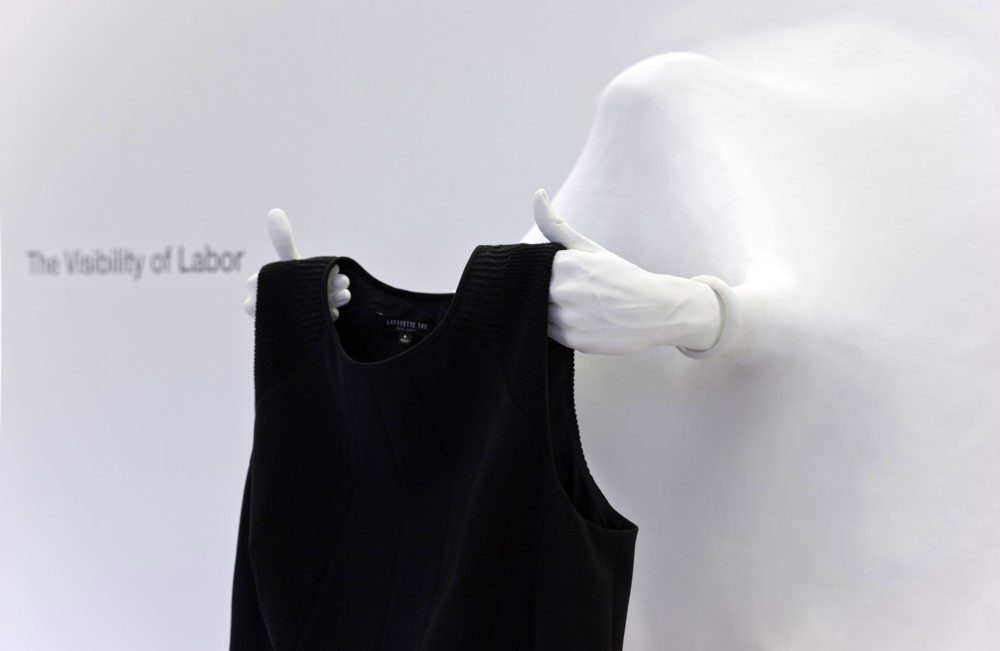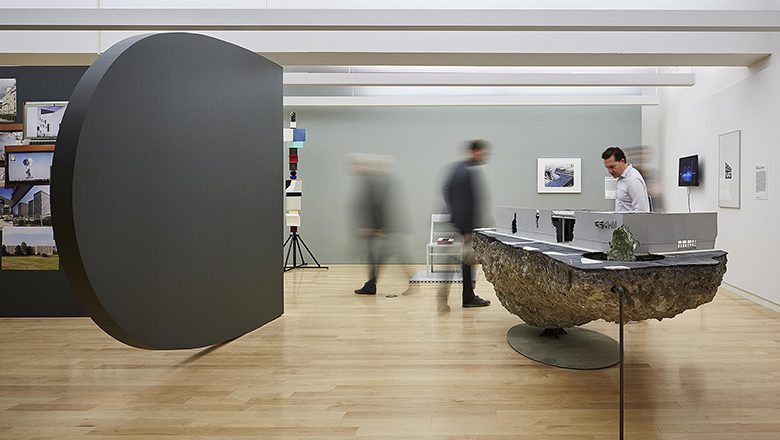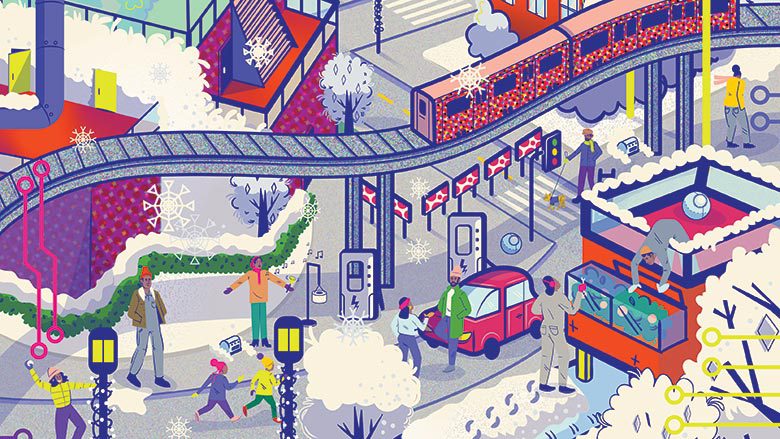
In many ways, the city of the future is already here. But while advanced technology has become a ubiquitous feature of urban life, it’s far less flashy than the pneumatic tubes, flying cars, or holographic billboards that have long populated science fiction. In fact, when it’s working well, urban technology is more likely to be invisible.
Transit agencies use artificial intelligence to predict demand, making the bus more convenient and reducing carbon emissions. Streetlights connected to the Internet allow cities to keep up with maintenance and ensure that the lights stay on. Even modern 311 systems, which let citizens report problems to City Hall from an app, represent a quiet technological revolution.
“There are things happening today that are not necessarily the sort of shiny objects that you can look at but that are still very important in terms of making cities better places to live,” says David Leopold, M.U.P. ’05, director of city solutions at the Chicago–based City Tech Collaborative, which brings together municipal agencies, nonprofits, commercial companies, and universities to find technological solutions for urban issues. “And planners are starting to explore how to apply these new skills and tools — data creation and management, sensing, predictive analytics, modeling. If you think about it, planning has always been about imagining a future based on a community’s civic goals, and these new technologies are helping us chart a course to get there.”
All that means the time is right for a new undergraduate degree that places urban technology at its center, says Bryan Boyer, assistant professor of practice in architecture and founding director of Taubman College’s new Bachelor of Science in Urban Technology, which will launch this winter with its inaugural cohort of students. The program will be the first undergraduate degree in urban technology offered anywhere, positioning Taubman College as an early leader in education for this emerging field.
“New technology deployed in a city can create as much of a shift as building a new neighborhood,” Boyer says. That means the stakes are high for everyone when it comes to training the next generation of urban technologists — and Boyer believes Taubman is well positioned to lead the way. “When digital products and services rewire our everyday lives, we need the people designing those systems to understand not just the technical side but also urban implications and urban values,” he says.

The future of the field
As the college began developing the new urban technology curriculum, the first alum that Dean Jonathan Massey turned to for help was Josh Sirefman, M.U.P. ’03. A member of Taubman College’s new Urban Technology Advisory Board, Sirefman is senior adviser and co-founder of Sidewalk Labs, a subsidiary of Google’s parent company, Alphabet, that is best known for working to develop a new mixed-used neighborhood in Toronto. Although Sidewalk Labs pulled out of the Canadian metropolis in 2020, citing economic uncertainty in the midst of the COVID-19 pandemic, Sirefman is applying lessons learned from that project to other efforts, including advising Taubman College on its new program.
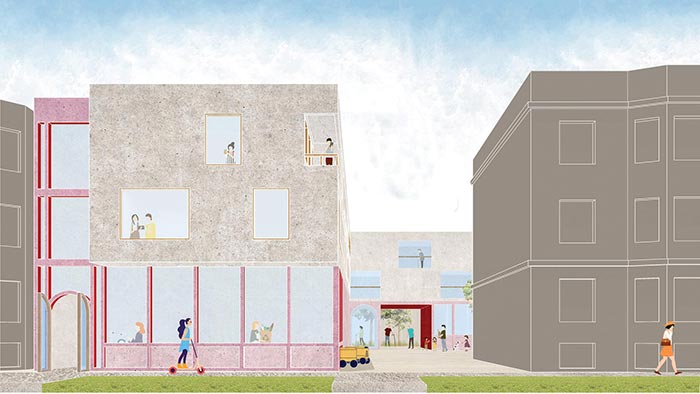
“The reason why a program like this is so exciting is because it’s really difficult to effect meaningful change and innovation in the urban context,” Sirefman says. “You have to not just understand what technology can do and create a technology-driven product or strategy but you have to know how to work within communities, how to work with policy, how to understand the complex interplay between lots of different variables that make urban life what it is.”
The Taubman program, Sirefman says, will give students an opportunity to develop that skillset, and, in turn, he hopes its graduates will help ensure that urban technology is used as a force to make cities better for everyone. That could include not only using technology for standard urban applications, such as improving transit systems, but also big-picture challenges like climate change. Virtual power plants, for example, are a form of distributed electricity generation that, in conjunction with Internet-connected smart meters in buildings, can respond immediately to changes in demand, which reduces waste and keeps greenhouse emissions down. Urban technology also could help mitigate the affordable housing shortage that has become a crisis in many U.S. cities if, for example, artificial intelligence could help architects and builders optimize the use of materials to reduce construction costs.
“There’s so much opportunity to understand how technology can contribute to addressing urban issues — it’s the future of the field,” Sirefman says. “And it can be applied across so many different categories of careers — whether urban planning or development or social issues, technology is going to be at the core of it. There will be massive opportunities for graduates with this skillset. It’s going to be increasingly in demand.”
Data-informed public health, public policy, public art
While the new program doesn’t welcome its first cohort until January, Taubman students and faculty are already deep into exploring the potential for urban technology.
Anthony Vanky, an assistant professor of urban and regional planning, researches the use of digital sensors and data in urban contexts. As co-founder of Social Studies, a consulting and research and analytics firm, he has worked with clients including the City of New York Planning Department to look at how people use spaces by studying their “data exhaust,” which are the byproducts of cell phone data or mobile apps that trail them as they travel around. Vanky also mentored a wastewater epidemiology startup that calculates drug overdose rates at the neighborhood level via the microbes present in city sewers, as well as a startup that uses artificial intelligence to enhance agricultural production and one that creates 3D models of homes using residents’ smartphone cameras.
Robert Goodspeed, an associate professor of urban and regional planning, uses GIS, or geographic information systems, along with so-called “big data” to study social issues like eviction, aiming to help cities work better for communities of color, the poor, and other marginalized groups whose voices aren’t always heard in conversations about planning. His work also has explored the idea of “civic crowdfunding,” which uses a digital platform to help community-based organizations recruit volunteers and raise money from individuals for community projects.
“It could be public art,” Goodspeed says, “or it could range all the way up to building brick-and-mortar projects like community centers. There’s no venture capital. It’s about using technology like social media and an online platform to build community and improve urban quality of life. So I think there are urban tech career pathways not only through the private sector but also through the public sector and through social entrepreneurship — where students may lead various initiatives through existing nonprofits or by founding their own social enterprise.”
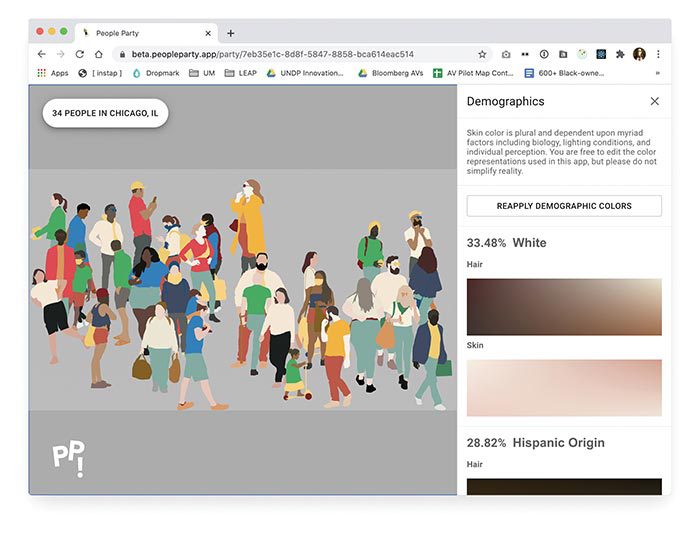
These endeavors, Goodspeed notes, require a new combination of skills: “You need to know something about technology but also about how to work with communities. I think the new degree will be right at that sweet spot.”
The complicated give-and-take of urban life
Urban and community values will be crucial for students pursuing careers in the public or nonprofit sector — but they’ll be just as important if, like so many brilliant programmers before them, Taubman College’s urban technology graduates are drawn to Silicon Valley instead.
“There are already tons and tons of companies that are doing things that affect your everyday, brick-and-mortar life,” Boyer says, offering as examples the now-ubiquitous ride-hailing apps and the popular Internet-connected doorbell camera Ring. “There are so many ways tech is changing our utilization of and relationship with existing city fabric. Think about the next person who starts a company like Uber or Ring, or the person who figures out how to design and supply affordable housing at scale. Should that person only understand computer science and entrepreneurship, or should they also have a civic ethos and appreciate the complicated give-and-take of urban life?”
Wenting Yin Thomas, M.U.P. ’16, a user experience researcher at Uber in San Francisco, strongly believes in the latter option. Her current role involves interviewing and surveying the millions of people who use the platform to earn money driving rideshares or delivering food, then analyzing the data in order to help the company understand its earners’ needs. She studied the gig economy, in which companies like Uber, Lyft, DoorDash, and more rely heavily on urban technology, at Taubman — and now, from the perspective of an industry insider, she’s been impressed by earners’ creativity.
“I met a driver who was also working in real estate, using the opportunity to reach out to a wider customer base,” Thomas says. “You can see that this gig economy tool is really opening up more opportunities to different types of people. And then during this past recession and lockdown period, when there were so many people losing their jobs, they could pick up on the gig economy to make a living right away.”
The gig economy, which has altered much about city life in recent years, also has been the target of criticism because the people who drive or deliver food — earning money for the company as well as themselves — don’t receive the benefits or protections typically afforded to employees. Meanwhile, flexibility is a top reason for the popularity of the gig economy — people can earn with multiple apps, drive whenever and for as long as they want. Studies have also shown that in some cities, home-share platforms like Airbnb have an adverse impact on long-term rentals, while ride-sharing has cut into the revenue of transit agencies. “There are complex problems with sharing economy,” Thomas says, “but that’s why I love my work, providing solutions in a complex system to help people.”
While the flashier aspects of urban technology — those autonomous cars Uber has been working on, perhaps — might suggest a futuristic city becoming less human, technology also can be humanizing, especially when it’s used to help people better navigate their city. Ruoshui “Rosie” Liu, M.U.R.P. ’19, is a research analyst at the nonprofit Data Driven Detroit, where she works on so-called “data portals” that help residents access information about their city.
“We get people the information they need to help with their decision making,” Liu says, describing the interactive maps and data visualizations Data Driven Detroit, or D3, creates for researchers, advocates, activists, and regular people who are simply seeking services. That could mean information about housing, daycare providers, public health, land use, and just about anything pertinent to the work of urban planners and the lives of urban residents.
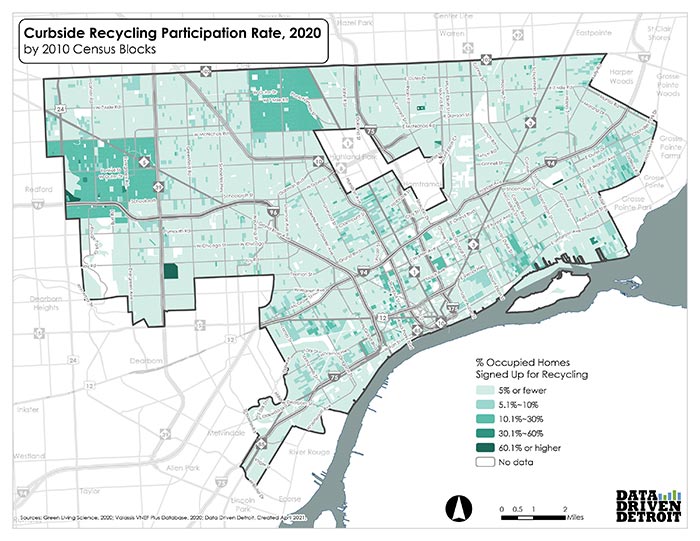
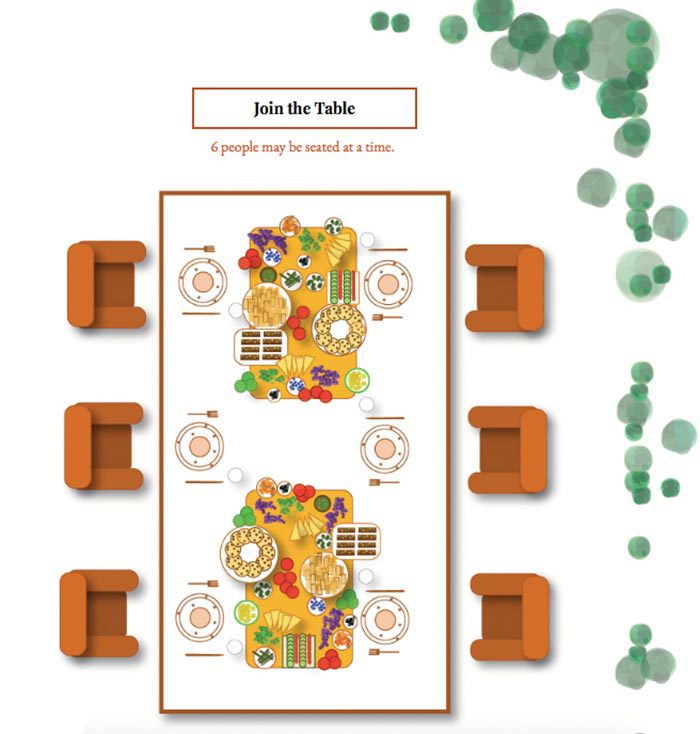
(Left) Data Driven Detroit is mapping residents’ participation in curbside recycling programs. (Right) MEDDY’s Community Table brings people together anonymously for conversation around difficult topics.
Detroit residents seem to have a thirst for data, but while more and more of it is being made available online — census and election records, figures from municipal agencies, health surveys, business directories, and university research — processing and interpreting what can feel like a firehose of information is tough. “Data’s always there,” Liu says, “but the challenge is to make data useful.”
What’s useful depends on who’s asking — and a service called “AskD3,” which allows Detroit residents to send their own requests for data, sometimes turns up surprises. “We get some real interesting requests,” Liu says. “I remember there was a story writer who wanted to know where all the haunted houses are, to be part of his inspiration for his new novel.”
That writer is not the only one using technology to inspire creativity. While at U-M, Rachel Jaffe, ’17, who studied urban and regional planning and information science, worked with the transportation department in Montgomery County, Maryland, to create its first-ever official technology strategy. She also interned with the software company Esri, where she modeled tools for urban planning. But she “caught the entrepreneurial bug” at Taubman College and now is the founder and principal of MEDDY Interaction Art Studio.
MEDDY is a New York–based startup that hosts interactive digital experiences, including “For Better or Better,” a Valentine–themed networking event for people also interested in self-improvement, and “Community Table,” a safe, anonymous place for people to discuss difficult topics like racism over audio-only chats with strangers. MEDDY’s projects are about storytelling and community building, using digital technology at an intimate, human scale — something that’s also key when technology is applied to city life.
“With urban tech, self-driving cars are always the example that you go back to because that’s very shiny,” Jaffe says. “But that sort of thing takes attention away from questions like, ‘How can we make the city better for the food delivery bicycle guy or the woman who cleans houses and has to cart her equipment on the bus?’ Technology can be cool and flashy and fun, but a city is about relationships and networks and people.”
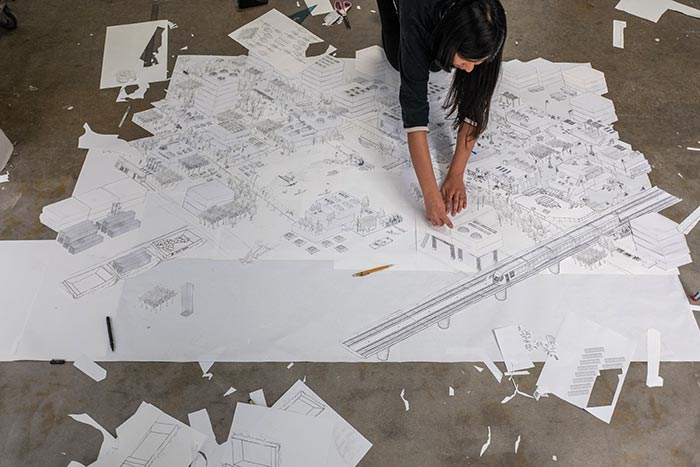
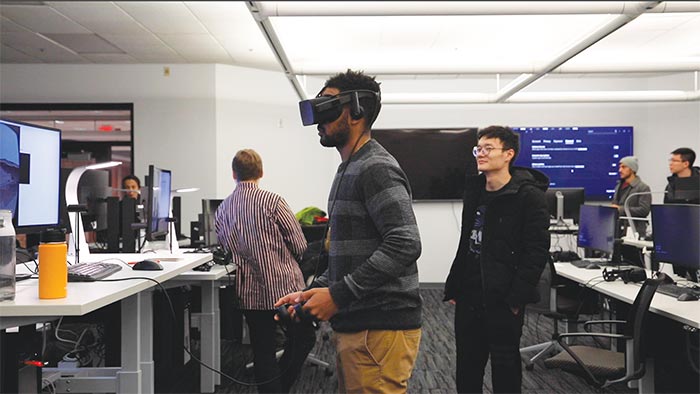
Urban technology students will leverage Taubman College’s culture of making and experimentation, including incorporating virtual reality into the classroom.
Ready for students who want to make things happen
At Taubman College, faculty are looking forward to winter term, when they’ll welcome the first cohort of 20 urban technology students. Their applications revealed a diverse group, ranging from hardcore programmers with experience on the high school robotics team to students with a design bent who want to explore new tools to urban policy wonks looking for efficient ways to make change. Some were taking on their own urban technology projects already, such as reducing vehicle congestion in front of their school by better managing traffic flow or improving the bus network in their hometowns.
“I’m thinking of this as almost a liberal arts program for students want to make things happen in today’s cities,” Boyer says. Still, noting the daunting issues the next generation faces — serious challenges like climate change and affordable housing — Boyer says, “It’s great to come to an understanding about what’s not working in the world around you, but then what do you do about it? I tell prospective students, ‘Don’t come to urban technology if you’re looking for something that’s easy, because it’s not going to be easy.’ We’re talking about designing the future of cities.”
— Amy Crawford







